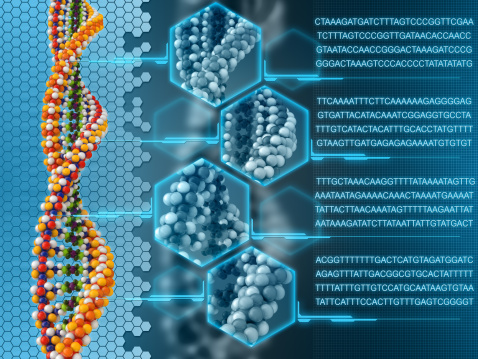GENETIC ENGINEERING


Advancements in Molecular Biology have transformed the way we produce Proteins of interest from Microorganisms. In earlier days, a Cell was considered to be the prime factor in the production process and much work was done to optimize parameters concerning its growth and output. We have now learned that the controlling factor behind the synthesis of specific proteins in all organisms goes back to its genome. Cells hold the basic blueprint of instructions governing the functions of an organism as the Genetic information or Genes. Genes contain the information for protein synthesis which determines the growth and other physiological and psychological characteristics. This information is present in the form of a genetic code which is a sequence of three nucleotide bases called a codon. Each codon codes for one Amino Acid in the protein chain.
DNA (Deoxyribonucleic Acid) are thread like structures present inside the chromosome of a cell. They contain the genetic code in a twisted ladder like manner. The shape of the DNA is referred to as Double Helix since they contain twisted parallel strands which run in the opposite direction. They are composed of subunits called Nucleotides which are further composed of a phospate group and a sugar which serves as the backbone and a nitrogenous base which is inside the Double Helix structure. The four common bases in the DNA are Adenine (A), Guanine (G), Thymine (T) and Cytosine (C). Adenine (A) pairs with Thymine (T) to form AT and TA while Guanine (G) pairs with Cytosine (C) to form GC and CG ladders of the Double Helix structure.
Recombinant DNA Technology is of prime interest for production of proteins from Genetically Engineered Cells. Recombinant DNA is the process of isolating and cutting a part of DNA of a Microorganism and inserting it into a Plasmid which serves as the Vector. Both the Plasmid and the DNA fragment of interest are cleaved using the same Restriction Enzymes which act as the biological scissors for cleaving DNA fragments. The DNA fragment is joined with the Plasmid using yet another class of enzymes known as Ligase Enzymes. This Plasmid is then inserted into a host cell where it Transforms the host cell which takes the foreign DNA and incorporates it into its genome.
The actual process of synthesis of proteins begins with Transcription, where a RNA strand known as mRNA (Messenger RNA) is copied from the DNA strand using it as a template. This is initiated by RNA Polymerases which bind to the promoter gene in the DNA and start the unwinding process. The transcription of the RNA moves ahead to a process called as Elongation where the base sequence of the DNA is read and synthesized. The base sequence present at the end of the DNA is called Terminator which ends the transcription process and releases the RNA chain. The newly synthesized mRNA nows leaves and binds with the Ribosomes present in the cytoplasm which further read and synthesize the Proteins according to the code present in the mRNA in a process known as Translation.
The challenge in developing a novel portfolio of Genetically Modified Cell factories which mass produce the proteins of interest is perfecting every step of the above processes. Large amounts of data pertaining to genomic sequence of each species of cells have to be processed prior to creation of vectors and inserting them into the target host cells.
Noor Enzymes is presently engaged in Research. Identification and Study of the genetic structure of a multitude of host microorganisms for development of a novel platform for Gene Expression. Upon development of a novel expression platform, which would as a Proprietory Host for expression of a wide range of target genes, we are looking to move ahead with active commercialization of the process.
Technology


